Charger Efest LUC V4
Efest has modified this charger and a update review has been published
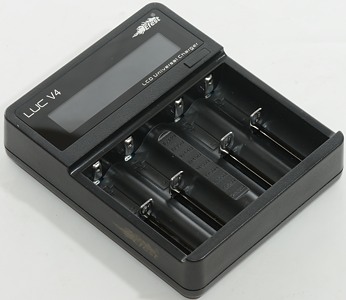
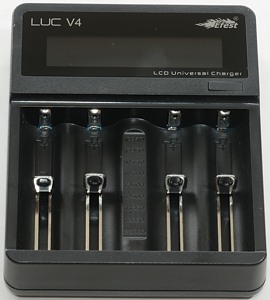

Efest has been building a line of chargers from single cell to four cell with fixed and variable current, this is a 4 channel LiIon charger with 3 charge currents.
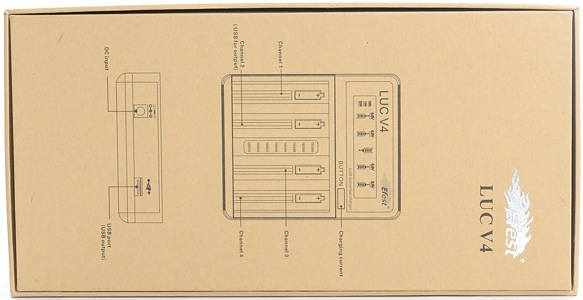

The charger comes in a brown cardboard box with a list of supported batteries.
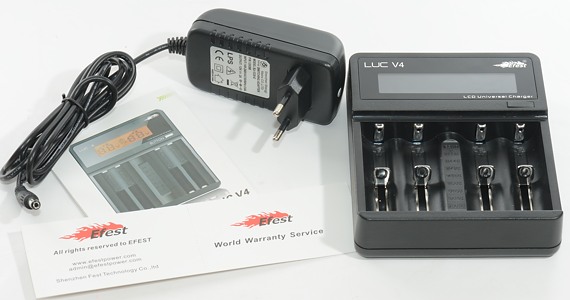
In the box is the charger, a power supply and a manual.

The charger is powered from 12 volt and has an usb output. The usb output can only be activated when no power is connected to the input.
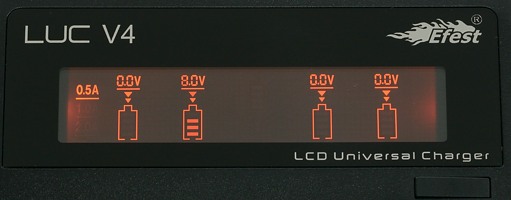
At 0.5 and 1A current the charger can charge 4 batteries. The two arrows are animated while charging.
The voltage display shows the battery voltage (The 8 is due to mixing of digits during long exposure, not because the display showed 8).
Below the display under the word "Charger" is the button, it is used to select charge current and to activate usb output (when possible).
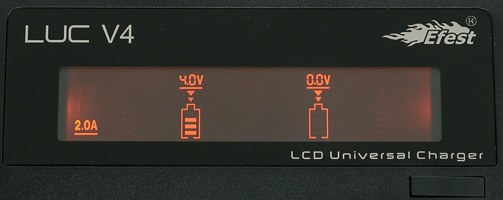
At 2A current only the two center slots can be used, this is clearly illustrated on the display.
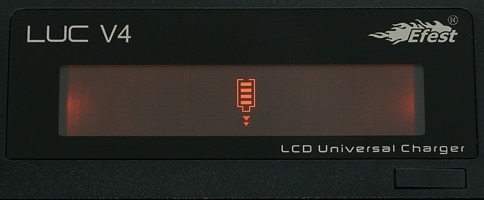
Usb output uses a icon in the center. This does not indicate what slot to use (It is slot #2).
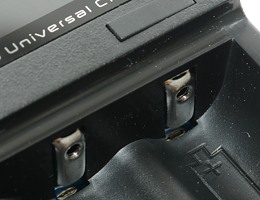

The sliders for the battery work smoothly and can accept batteries from 30mm to 70.5mm.
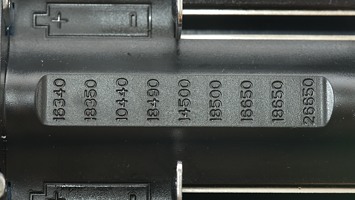
Between the batteries is a list of supported battery sizes, but the 10440 size is only valid for IMR cells.


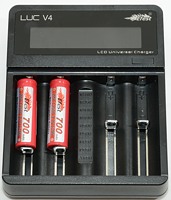

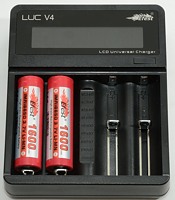

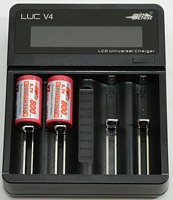

The charger can handle 70 mm long batteries including flat top cells.
The charger is rated for 10440 batteries, but due to the charger current it is only recommended to charge IMR 10440.
Note: Using to high charge current will not make the batteries explode, but will reduce lifetime of the batteries.
Measurements
LiIon at 4.2V (ICR/IMR)
- When not connected to power it will discharges with up to 0.09mA, except the USB out channel that will discharge with 0.15mA.
- When the battery is full the charger will discharge with about 0.1mA.
- If the voltage drops below 4.05 volt the charging will restart.
- Power cycling or reinsertion of the battery will restart charging.
- At about 0.65 volt the charger will detect a battery and start charging with 150mA
- The current will drop to 60mA at 3 volt, where the full charge current is applied.
- The voltmeter is limited to 4.2 volt, if the voltage get much above 4.2 volt it will show 0.0 volt.
- The voltmeter shows about 0.06 volt to low.
- The channels on the charger are independent, i.e. there are small differences between them.
%20%231.png)
The charger does a good CC/CV charge curve with a good termination current, but it charger to 4.28 volt, not 4.20 volt (Maximum 4.25 volt), this is not good.
%20%231.png)
With 1A it is exactly the same, very good CC/CV charge curve, but to high a voltage.
%20%231.png)
It looks like the over charge protection in the 2600mAh cell tripped (The other cells I test with are unprotected).
%20%231.png)
The 3400mAh is exactly the same as the 3100mAh cell, to high charge voltage.
%20%232.png)
With 2A current and a Efest 26650, the result is again the same. The termination is slow, probably due to the high voltage.
%20%231.png)
With my old IMR 16340 cell the termination is also slow.
%20%232.png)
%20%233.png)
%20%234.png)
The other 3 slots looks close to the first slot, all slots are over charging.
.png)

M1: 39,1°C, M2: 40,9°C, M3: 40,2°C, M4: 40,2°C, M5: 41,5°C, HS1: 57,2°C
The heat from the charger is distributed fairly even across the batteries.

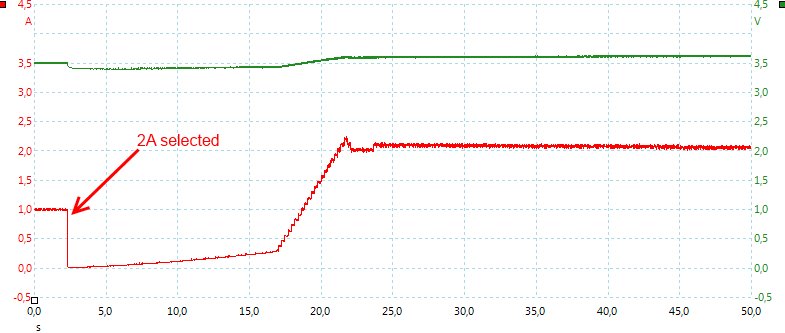
The charger does slowly ramp the current to the selected charger current, changing the selection will start a new ramp from 0.
USB output
- When using usb output, the symbol will flash when the battery is nearly empty
- When usb output is on, but unloaded, it will draw about 12mA.
- Usb output turns off after about 30 seconds with a load below 30mA.
- It is not possible to turn off the usb output with the switch.
- When mains power is connected, the usb output is off.
- Usb output is coded as Apple 1A
- Usb output will turn off when overloaded
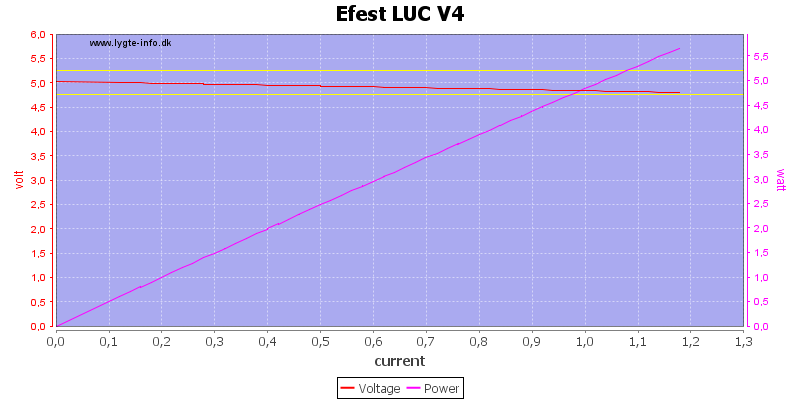
As usual I do a load sweep first, to see how the output works at different loads. The LUC turns off at 1.15A, this is good for a 1A rated output.
.png)
Only one battery is used for usb output (Slot #2), here I am running with a 0.5A load, the output turns off when the battery is down to just over 3 volt. The efficiency is good at 85% to 90%.
.png)
2600mAh has shorter runtime.
.png)
3400mAh has longer runtime.
.png)
Increasing the load to 1A, show that the output has some trouble just before the battery is empty.

With 7mV rms noise and 108 mV peak-peak noise the output voltage is good.

With 1A load the rms noise increases to 9mV and the peak-peak to 110mV, again a good value. The trouble just before the battery is empty will, of course, have much higher noise.
Testing with 2500 volt and 5000 volt between mains and low volt side, did not show any safety problems.
Conclusion
The charger uses the correct algorithm has a good termination current and I like the design, but the high charge voltage is not acceptable.
The usb output does also work fine, but I do not know how much use it is in this type of charger. If it had been powered when the charger was powered, it would probably be more useful.
If Efest fixes the high charge voltage it will be a good LiIon charger, but before that happens it is not very good.
Notes
The charger was supplied by Efest for review.
Here is an explanation on how I did the above charge curves: How do I test a charger
Read more about how I test USB power supplies and chargers





















%20%231.png)
%20%231.png)
%20%231.png)
%20%231.png)
%20%232.png)
%20%231.png)
%20%232.png)
%20%233.png)
%20%234.png)
.png)




.png)
.png)
.png)
.png)

